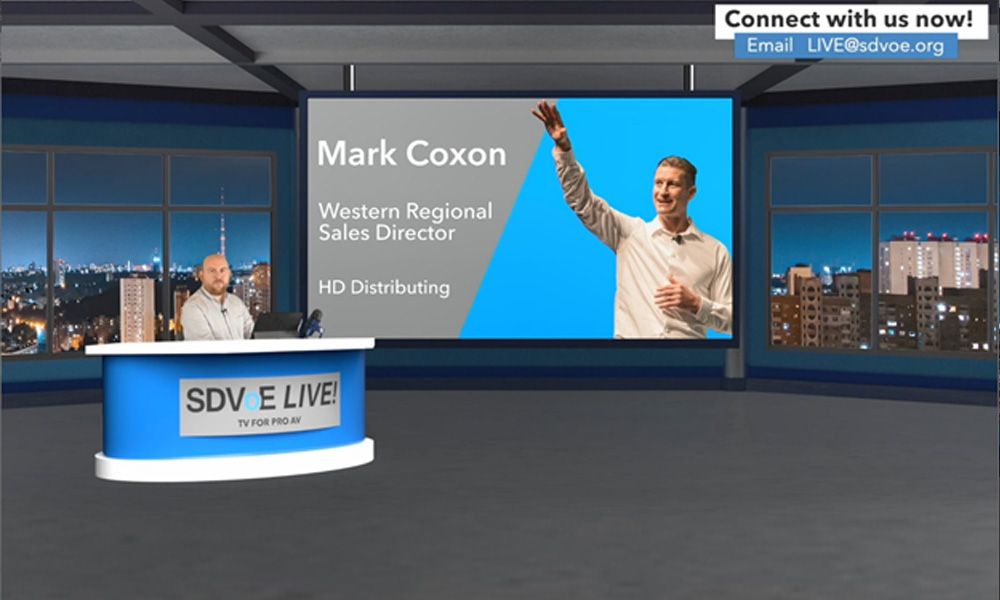Standardization and a Business Model Shift May Mitigate Supply Chain Issues
 During a recent episode of SDVoE LIVE!, Justin Kennington and Mark Coxon discussed the current state of procuring equipment for AV installations. Are shortages, weather events, ships stuck in ports, and a global health challenge—forces beyond our control—causing all the supply chain issues? Did we as an industry contribute to putting ourselves in the current situation? Are their approaches we will want to adopt to ease the pain of this problem in the future?
During a recent episode of SDVoE LIVE!, Justin Kennington and Mark Coxon discussed the current state of procuring equipment for AV installations. Are shortages, weather events, ships stuck in ports, and a global health challenge—forces beyond our control—causing all the supply chain issues? Did we as an industry contribute to putting ourselves in the current situation? Are their approaches we will want to adopt to ease the pain of this problem in the future?
Here are a few highlights from the conversation. You can listen to the more in-depth discussion by watching the on-demand episode of SDVoE LIVE! “AV Supply Chain Disruption: Is It Our Own Fault?”
- In the evolution of the AV industry, integrators have built “walled gardens” for their end users. We purchased from vendors who provided very specific equipment. They may have been the only manufacturer at the time, and we needed their gear to make our systems work. Those manufacturers expanded their own ecosystem, and we based our business model on one manufacturer.
As competitors manufactured comparable equipment, we could not switch or shop around because there were no standards of interoperability between brands. Mark posits that our end users will pull us into the future demanding standards and interoperability. - Mark suggests that another area to ward off supply chain issues is to minimize our dependence on hardware. As the AV industry moves toward providing virtualized equipment, software, and services, the need for specialized hardware lessens. This gives integrators more flexibility to select the products they need to complete an installation that meets the end-users needs. They can now focus first on the design and use of the system, and then find the parts to make that happen. The keys here are standards and interoperability. If an integrator’s main supplier experiences shortages, they can shop around for alternatives that will work with their systems.
Perhaps the AV industry can look at other industries that have already made the move to products that are standards based and are compatible across brands?
- One of the biggest challenges is that our business model is built on hardware. As integration firms move into this new world of virtualized equipment, how do we adapt our business and compensation models? How do salespeople get paid? How do engineers get paid? How does the company monetize a virtual control system? How do you create a revenue plan? Or how do you know what the retention’s going to be year over year? So, all of those things in a subscription service model are a lot different than running a business with a hardware-based model.
AV in Higher Ed Tech in the news
Justin highlighted several recent articles in the news focusing on the current state of supply chain within the AV industry. Read “The Supply Chain Gap – Is It Our Own Fault?,” “Supply Chain and Shipping Issues Continue to Impact AV Product Prices, Availability,” and “Out of Stock: A Look at the AV Supply Chain” for more insights. Find links to them in SDVoE Academy on the archived show page “AV Supply Chain Disruption: Is It Our Own Fault?.”
What’s next?
Join us every other Tuesday at 1 PM ET (New York) for a fresh episode of SDVoE LIVE! in SDVoE Academy or on THE rAVe Agency’s LAVNCH platform.
Upcoming SDVoE LIVE! shows
Join us on Tuesday, January 25 for our next episode, “AV and IT Problems – Human Solutions.” Get the latest info at sdvoe.org/live/.

